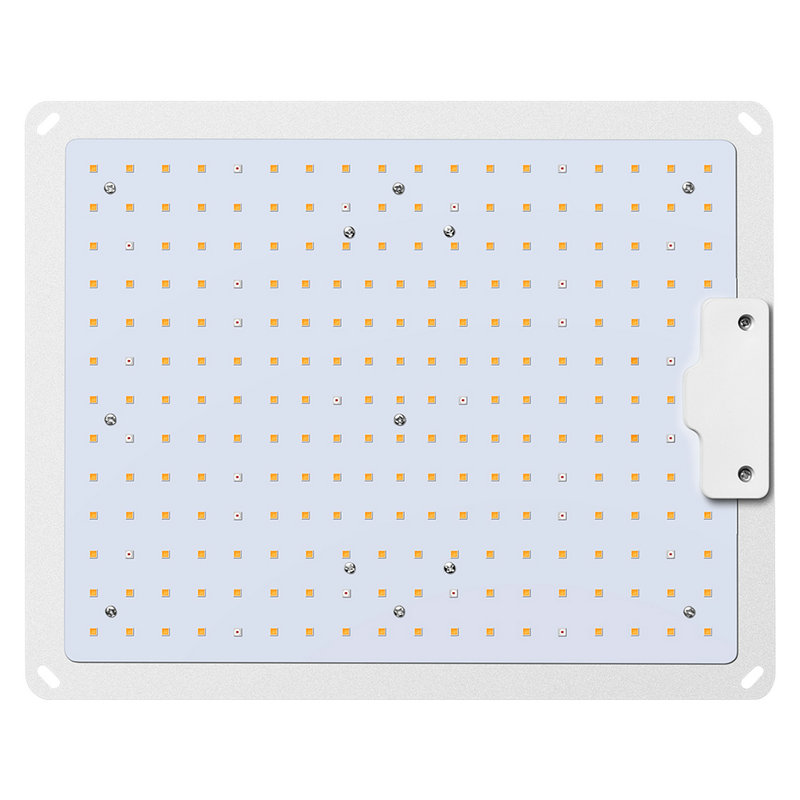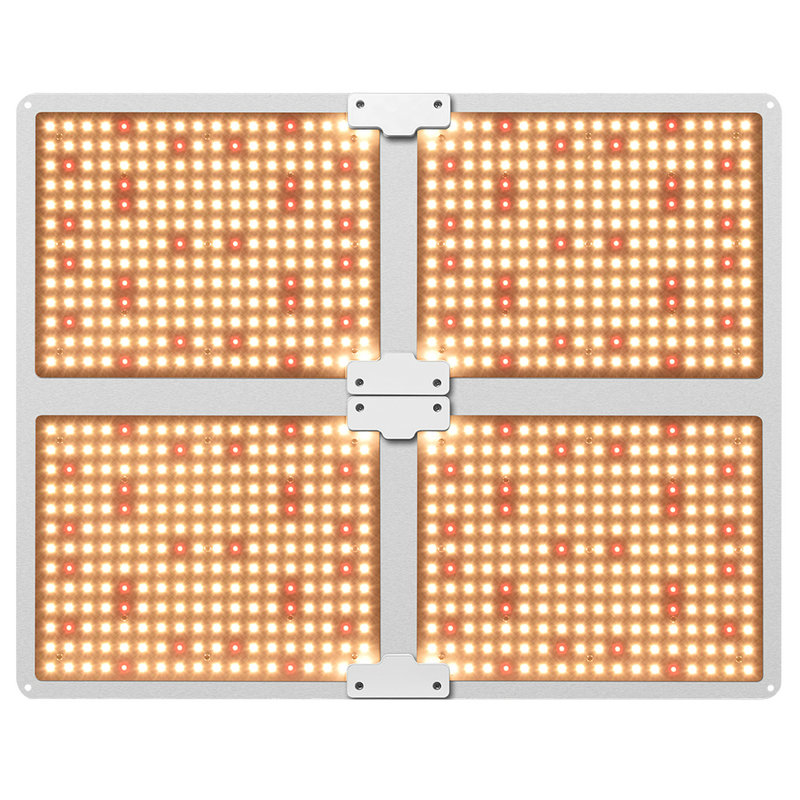What is the prospect of LED grow lights?
2020-10-21
LED grow light introduction
Light environment is one of the important physical environmental factors indispensable for plant growth and development. Through light quality regulation, controlling plant morphology is an important technology in the field of facility cultivation.
LED grow light uses LED (Light Emitting Diode) as the light source. According to the law of plant growth, it must need sunlight. It is a kind of lamp that replaces sunlight with light to provide the environment for plant growth and development.
LED plant lights help shorten the growth cycle of plants, because the light source of this kind of light is mainly composed of red and blue light sources, using the most sensitive light band of plants, red light wavelengths use 620-630nm and 640-660nm, blue wavelengths use 450-460nm and 460-470nm. Let plants promote the differentiation of multiple side branches and buds during the growth process, accelerate the growth of roots, stems and leaves, accelerate the synthesis of plant carbohydrates and vitamins, and shorten the growth cycle.
A large number of application research results of LED in plant facility cultivation environment show that LED grow light is particularly suitable for artificial light control type plant facility cultivation environment.
The color temperature and lumens of artificial light sources can be seen by the eyes of living creatures, while the demand for light of plants is photosynthesis, which is determined by the radiance value without looking at the color temperature and lumens.
The effect of spectral range on plant physiology
·280~315nm————"This wavelength is already ultraviolet light, which has the function of directly suppressing the growth of various animals, plants and even fungi, and has minimal impact on morphology and physiological processes.
·315~400nm————"This kind of light wave is also a kind of far ultraviolet light. Although it does not harm plants, it has no direct effect on plant growth. The absorption of chlorophyll is small, which affects the photoperiod effect and prevents stem elongation.
·400~520nm (blue)-"This kind of wavelength can directly develop the root and stem parts of plants, and has the largest absorption ratio of chlorophyll and carotenoids, and has the greatest impact on photosynthesis.
·520~610nm (green)-"Green plants are repulsively pushed, and the absorption rate of green pigment is not high.
·610~720nm (red)-"The chlorophyll absorption rate of plants is not high, but this wavelength has a significant effect on photosynthesis and plant growth speed.
·720~1000nm————"This kind of wavelength is generally infrared wavelength, which has low absorption rate for plants, can directly stimulate cell elongation, and affect flowering and seed germination.
·>1000nm---"The wavelength of the laser light has been approached and converted into heat.
From the above plant and spectral data, light of each wavelength has different effects on plant photosynthesis. Among the light required by plants for photosynthesis, 400 ~ 520nm (blue) light and 610 ~ 720nm (red) Photosynthesis contributes the most, and 520 ~ 610nm (green) light has a very low rate of effect on plant growth.
If according to the above principles, plants are only for 400 ~ 520nm (blue) and 610 ~ 720nm (red), the spectrum has the effect of directly helping the growth, so the plant lights under the academic concept are made into a combination of red and blue, all blue, all There are three forms of red to provide light of two wavelengths, red and blue, to cover the wavelength range required for photosynthesis of plants.
In terms of visual effects, the red and blue combination of LED grow lights are pink. This mixed light color is extremely uncomfortable for biological lighting, but it can only be used for practicality. Sex-oriented.
Generally white LED lamp beads, the most common is to use a blue core to stimulate the yellow phosphor to emit light, thereby compounding the visual white light effect. In the energy distribution on the integrating sphere test report, there are two peaks in the blue area at 445 nm and the yellow-green area at 550 nm.
The 610 ~ 720nm red light required by plants has relatively little coverage and cannot supply the light and light efficiency required for the planting plants. This explains why the growth rate and harvesting effect of plants are not as good as ordinary outdoor planting under the illumination of white light LED.
Using the above data, the chromatogram ratio of the red and blue lights of general plant lights is generally between 5:1 and 10:1. Usually, the ratio of 7-9:1 can be selected. Only the ratio distribution requires the brightness ratio of the lamp beads to be mixed. The light basis, the number of non-lighting beads is the light mixing basis.
When using LED grow lights for plant planting, the height from the leaves is generally about 30-50 cm. In this process, different light intensities are actually required according to the types of plants being planted. Adjusting the height is generally regarded as the easiest way to adjust the brightness.
Industry insiders explained that the shelves of large plant factories are equipped with special LED lights for plants, which are different from the general LED spectrum. In order to cooperate with photosynthesis, the spectrum of plant lights is blue and red. And according to different personal needs, it can also be adjusted to cold, Warm white light, with mobile APP remote control, the operation is very convenient. The industry said that the multi-story plant factory is equipped with a water circulation system, which can grow more than 100 kinds of plants after testing, which is suitable for mass production needs. In addition to household use, plant factories generally have two ways to make profits. One is the mass production of leafy vegetables, such as cabbage, qingjiang cabbage, lettuce and other cruciferous plants; the other is high economical cultivation such as ginseng and Antrodia cinnamomea. For valuable crops, as long as the specific LED spectrum and control system are used, seasonal crops with harsher growth conditions can be cultivated.
LED grow light market prospects
Not long ago, Taga City, Miyagi Prefecture, Japan, publicly displayed the world's largest LED (light emitting diode) artificial light plant factory to the media. The factory named "Mirai Hata" covers an area of approximately 2,300 square meters, uses 17,500 LED lighting, can be produced throughout the year, and is expected to harvest about 10,000 lettuce every day. Not long ago, Fujitsu also announced that after about a year of preparation, low-potassium lettuce produced by its own plant factory has begun to be put on the market.
Compared with traditional plant lights, LED plant lighting has obvious advantages of energy saving and high efficiency. The cost of LED plant lights in 2013 has fallen sharply compared to 2010. Each lumen is equivalent to NT$0.38, which is only 1/5 of the NT$1.8 in 2010. This has driven Philips, Osram, Mitsubishi, Panasonic and other major international manufacturers to invest. Innovative application of LED plant factories, Taiwan, which has the advantages of both LED and agriculture industries, certainly does not want to miss business opportunities, adding scientific and technological innovation to agriculture, so that enterprises will be worth 100 million yuan.
Japan is the country with the fastest development of plant factories. The government of this country took the lead in proposing a subsidy policy for plant factories in 2009, which caused the market demand for LED lighting in this field. According to statistics, the demand for LED panel lighting in plant factories in Japan was 1,000 units in 2009. In 2011, it rushed to 8,850 units due to the 311 earthquake. Although it declined back to 2,500 units last year, PIDA believes that the demand in the Japanese market will increase year by year. It is estimated that it will reach 3,200 units this year and 9,000 units in 2015. , To see 18,000 units in 2020.
Taiwan has also begun to smell the business opportunities of plant factories, and many LED companies have already begun to enter the market in this field. In addition to Jingdian and Everlight, there are also Canyuan, Guangding, Hongqi, Guanghong, New Century, Dongbei, etc. Since last year, the Council for Economic Development and Planning also wanted to support plant factories through channels to promote the revitalization of Taiwan’s agriculture.
However, Taiwan is small and densely populated, and development space is limited. Instead, the mainland China market, which has vast land and resources, is the target of all businesses. The Chinese government recently introduced the "Twelfth Five-Year Plan" 863 plan. Although the total funding is only about 46.11 million yuan (about 217 million yuan in new Taiwan), the plan for the first time includes the "Smart Plant Factory Production Technology Research" as a research project. Among the seven projects, including the application of LED energy-saving light sources in plant factories, it is obvious that the business opportunity of China's LED lighting application in plant factories is just preparing to rise.
In our country, after the implementation of the Chinese central government, the market is optimistic that local governments will follow up more actively. And if the Chinese government’s previous attitude of large-scale subsidies to the LED industry, the next business opportunities in the new field of LED lighting led by plant factories will also give everyone It is the next niche market development opportunity for Taiwan’s LED factories.
In the past, the cost of LED lighting remained high, and plant factories often adopted fluorescent tubes or high-pressure sodium lamps. With the decline in LED prices and the improvement of technology, a new wave of progress has been made in the application of LEDs in plant factories. At present, there are not many manufacturers of LED plant lights in China, and most of them are concentrated in Shenzhen.
At present, the sales market of LED plant lights is also concentrated in countries and regions with fewer agricultural personnel such as Japan, South Korea, China and the United States, and Europe.
to sum up:
With the extensive development of the LED industry, LED companies are constantly looking for new development paths. LED grow lights are undoubtedly an opportunity for LED companies to rebirth. However, despite the promising prospects of plant growth lights, the development of plant factories still faces some "bottlenecks" ". For example, if the initial investment is too large, an artificial light plant factory with a daily production of 1,000 lettuce generally requires a relatively high initial investment. Even if the government subsidizes 50%, it usually takes 5-7 years to achieve profitability. In addition, the planting technology in the age of factory agriculture has yet to mature, and related quality control and logistics sales models are also being explored.








